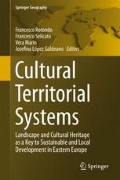Abstract
The aim of this chapter is to understand the ways in which one can implement, monitor and modify an integrated cultural territorial plan during the operational period. The goal is to give a series of suggestions as well as some thoughts on how the plan will be monitored and, especially, by whom. The management and implementation steps of the plan are not secondary; rather they represent a new critical point that, if not properly addressed and resolved, may not allow the plan to achieve the growth targets defined.
Access this chapter
Tax calculation will be finalised at checkout
Purchases are for personal use only
References
Akgün AA, van Leeuwen E, Nijkamp P (2012) A multi-actor multi-criteria scenario analysis of regional sustainable resource policy. Ecol Econ 78:19–28 (Elsevier)
Bottero M (2011) Indicators assessment system. In: Peano A, Cassatella C (eds) Landscape indicators. Assessing and monitoring landscape quality. Springer, Dordrecht
Bottero M, Levi Sacerdotti S, Mondini G (2013) La valutazione delle politiche turistiche: un’applicazione del visitor management al caso dei paesaggi piemontesi. In: Barosio M, Trisciuoglio M. I paesaggi culturali. Costruzione, promozione, gestione. Egea, Milano
Cercola R (1999) Economia neoindustriale e marketing territoriale. Sviluppo e organizzazione 172:67
De Marchi B, Ravetz J (2001) Participatory approaches to environmental policy. Environmental valuation in Europe. Policy Research Brief.: Cambridge Research for the Environment, no° 10
Kelsey C, Gray H (1986) The citizen survey process in parks and recreation. American Alliance for Health Physical Education, Recreation and Dance, Reston, VA
Marenna M (2005) Un’analisi teorica sul Marketing territoriale. Presentazione di un caso studio. Il “Consorzio per la tutela dell’Asti”. Ceris-Cnr, W.P. No° 7
Mega V, Pedersen J (1998) Urban Sustainability Indicators. European Foundation for the Improvement of Living and Working Condition, Dublin
Ministero per i Beni e le Attività Culturali (2005) Progetto di definizione di un modello per la realizzazione dei Piani di Gestione dei siti UNESCO
Montibeller G, Gummer H, Tumidei D (2007) Combining scenario planning and multi-criteria decision analysis in practice. J Multi-Crit Decis Anal 14:5–20 (Wiley)
Puglisi M, While A (2004) Futures work in urban and regional governance: rhetoric or reality? In: EURA-UAA Conference ‘City Futures—An international conference on globalism and urban change’, Chicago, USA
Regione Umbria, Centro di Ricerca Focus (2009) Linee Guida per la definizione del Quadro Strategico di Valorizzazione. Perugia. http://www.centriurbani.regione.umbria.it/ Accessed 08 April 2015
Salone C (2005) Il territorio nelle politiche. Reti di soggetti, risorse localizzate e vantaggi competitivi nei processi di sviluppo locale. In: Dematteis G, Governa F (eds) Territorialità, sviluppo locale, sostenibilità: il modello SLoT. Franco Angeli, Milano
Santangelo M (2005) Transcalarità e multiscalarità dello sviluppo locale. In: Dematteis G, Governa F (eds) Territorialità, sviluppo locale, sostenibilità: il modello SLoT. Franco Angeli, Milano
Vreeyker R, Nijkamp P, TerWelle C (2002) A multicriteria decision support methodology for evaluating airport expansion plans. In: Transportation Research Part D 7, pp 27–47. Elsevier Science Ltd
Author information
Authors and Affiliations
Corresponding author
Editor information
Editors and Affiliations
Rights and permissions
Copyright information
© 2016 Springer International Publishing Switzerland
About this chapter
Cite this chapter
Loconte, P. (2016). Implementing and Reviewing Integrated Cultural Territorial Plans. In: Rotondo, F., Selicato, F., Marin, V., Lopez Galdeano, J. (eds) Cultural Territorial Systems. Springer Geography. Springer, Cham. https://doi.org/10.1007/978-3-319-20753-7_14
Download citation
DOI: https://doi.org/10.1007/978-3-319-20753-7_14
Published:
Publisher Name: Springer, Cham
Print ISBN: 978-3-319-20752-0
Online ISBN: 978-3-319-20753-7
eBook Packages: Earth and Environmental ScienceEarth and Environmental Science (R0)

